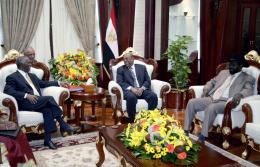
Today, July 5, representatives from Sudan and South Sudan recommenced negotiations in Addis Ababa following a week-long break for high level political consultations in Khartoum and Juba. A new Enough field dispatch, “A Comprehensive Agreement for the Two Sudans: Is It Possible?,” reviews the conversations that occurred during the last round of negotiations on the definition of the administrative common borderline, the modalities for determining the final definition of the north-south border, and the recent pace of the negotiation process.
The field dispatch further provides policy recommendations to the international community and the two Sudans. These recommendations are offered in an effort to mitigate the risk that Khartoum and Juba fail to reach a comprehensive agreement on all outstanding issues ahead of the August 2 deadline, established by the African Union Peace and Security Council and reinforced by United Nations Security Council Resolution 2046, for the conclusion of North-South negotiations.
The parties’ posturing during the last round of negotiations in many ways evidenced their respective views of the August 2 deadline and the urgency it poses, or not, for the pace of discussions moving forward. While South Sudan appears increasingly concerned over the fast approaching deadline and is making overtures to both Sudan and the AUHIP to increase the pace of the talks, Khartoum is not overtly concerned by the impending deadline and requested leave from the last round of talks to consult with leadership, further delaying progress.
Khartoum and Juba’s divergent positions aside, one thing is certain: time is running short and the only viable mechanism for consolidating peace and security between the two Sudans remains the conclusion of a comprehensive agreement inclusive of all outstanding North-South issues. The main issues at hand include security-related matters, the definition and demarcation of the north-south border, financial and oil issues, citizenship, and the final status of the Abyei area. As August 2 draws near, the question has now become, “Is it possible for the two Sudans to conclude a comprehensive agreement in the time that remains?”
To this end and in an effort to mitigate the risk that the parties will be left without a comprehensive agreement on August 2, Enough’s field dispatch recommends that the international community and/or the two Sudans should:
- Find an immediate solution to the current impasse concerning the definition of the administrative common borderline. The international community—in particular, the AUHIP, the U.N., the Sudan Troika, China, Ethiopia, Qatar, and other influential actors—should place appropriate diplomatic pressures on the government of Sudan to accept the November 2011 AUHIP map. Efforts should be made to allay both Khartoum and Juba’s concerns over the AUHIP’s map through, among other things, reinforcing the underlying assertion that acceptance of the map will in no way prejudice the two parties’ respective claims vis-à-vis the disputed areas; and further exploring options related to the demilitarization of the disputed areas per the South’s proposal, and/or the joint administration of the disputed areas.
- Work to ensure that Sudan and South Sudan come to agreement on the modality for determining the final definition of the North-South border as soon as possible and ahead of the August 2 deadline. Given that the parties have unsuccessfully worked since 2005 to define the border through negotiation, it appears most prudent to resort to alternative options, namely, arbitration. Previous experience with the Abyei area indicates that Khartoum, in particular, is prone to delaying the final status resolution of disputed areas, undermining agreements concerning prolonged joint administration of the same, and conflating administrative control with sovereignty. To avoid the creation of several Abyei-like disputed regions along the north-south border, the international community should immediately seek to persuade the government of Sudan to agree to final and binding arbitration to resolve conclusively the status of the disputed border areas.
- Simultaneous with continued negotiations on security, immediately commence talks concerning the other outstanding issues, namely, financial issues, inclusive of oil-related matters, citizenship, and the final status of the Abyei area. The ultimate goal of these negotiations must be the conclusion of a comprehensive agreement inclusive of all outstanding issues as soon as possible and ahead of the August 2 deadline.
- Commence immediately a North-North negotiation track, in addition to the existing north-south negotiation track. This North-North track should address current conflicts within Sudan by initiating negotiations between the Sudanese government and the military and political components of the Sudan Revolutionary Front, or SRF. The goal of this track should be the conclusion of a ceasefire agreement between government forces and the SRF, guarantees of unrestricted access for international humanitarian aid agencies throughout all regions of Sudan, and transitional political arrangements that pave the way for a transparent, all-inclusive, and participatory constitutional process and democratic elections.
Read the new dispatch: A Comprehensive Agreement for the Two Sudans: Is It Possible?
Photo: Sudanese President Omar al-Bashir, center, speaks with his South African counterpart Thabo Mbeki, left, and Sudan’s First Vice President Salva Kiir, right, in Khartoum, Sudan, in 2007. (AP Photo/Abd Raouf)

